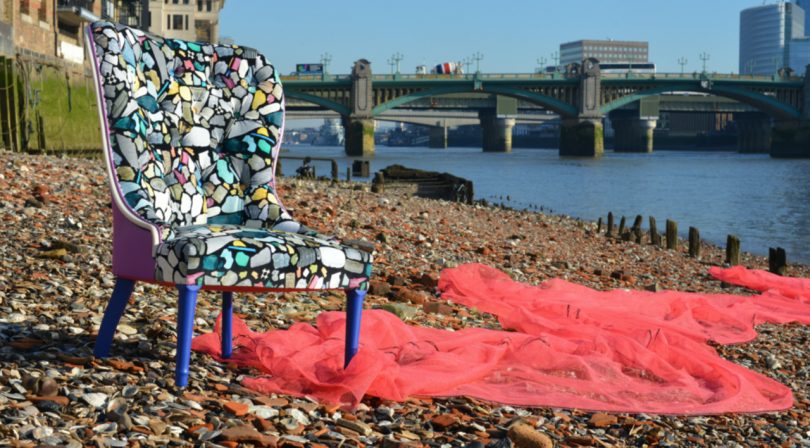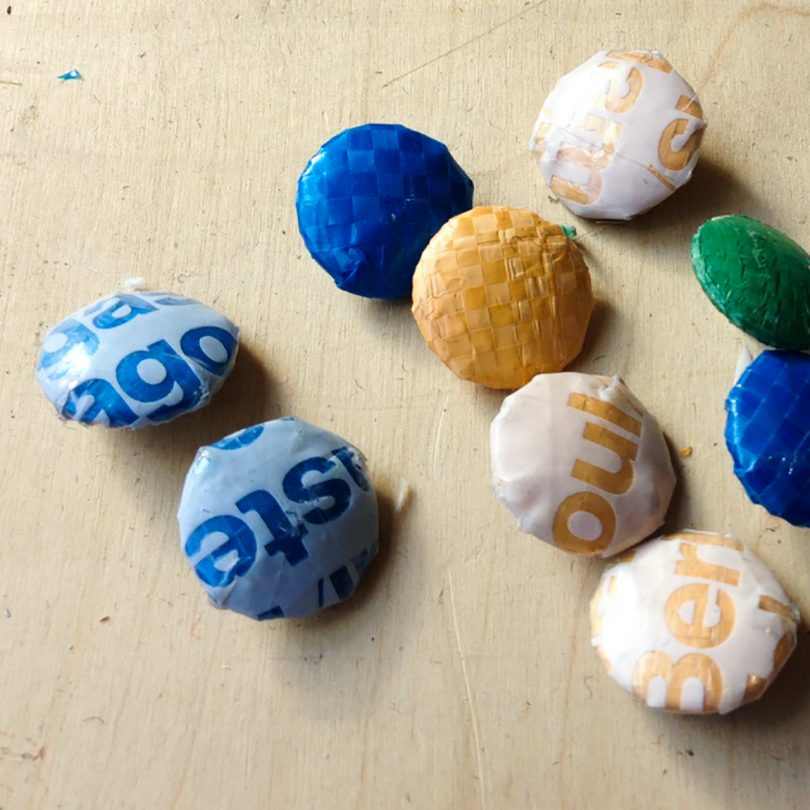The circular economy is a proposed alternative to our traditional ‘take–make–waste’ model of production and consumption – one that offers hope in the face of environmental catastrophes from climate change to ocean plastic. Designing out waste and pollution, keeping materials and products in use and regenerating our natural environment are so important to contemporary design that we have created a dedicated space for the projects bringing these ideas to life. Circular by Design, a fortnightly column by longtime contributor Katie Treggiden, starts by exploring the reuse of waste as a way to keep materials in use and bring the legacy of the linear system full circle.
Award-winning London-based designer Ella Doran set up her homewares business in the late 1990s, quickly winning fans and plaudits for her pioneering application of photography-based images and patterns onto functional, household products. Her involvement in the RSA’s Great Recovery project – and specifically, the restoration of a sofa that was bound for landfill simply because its fire safety label had been removed – sparked a renewed interest in, and commitment to, the circular economy. We spoke to her about her latest project, the Clean Up Plastic Camo Chair.
Tell me a little bit about your childhood, education and background in terms of how you first became interested in creativity, design and sustainability.
I was born in London and spent the first six years of my life moving between various towns and cities, because my Dad was at medical school. We then settled in Bristol and I attended a Steiner School until I was 14. Every week we had practical lessons in the creative arts integrated with our academic work, from needlework to pottery, from woodwork and painting to music – this gave me a very strong foundation and confidence in my own creativity and in making things from a young age. Until I was 18, I mostly lived with my Mum in a community surrounded by creative people. I had the best year of college life on my foundation course and from there I went on to study printed textiles at Middlesex University (then a polytechnic). I quickly learnt that I preferred designing for interiors rather than for fashion and the course focused on developing our own design language. In terms of sustainability in my own business, the size of my company has ebbed and flowed to remain viable, but the values I espouse and the materials I use have not changed – even though the communication and focus of what and how I design has developed over time.
How would you describe your Clean Up Plastic Camo Chair?
The Clean Up Plastic Camo chair is a one-off piece. The story of the chair is as much a part of the design process as the piece itself and is aimed at highlighting the wicked problems of plastics in our oceans and furniture going to landfill. It’s a truly collaborative project. I teamed up with Urban Upholstery (Andrea and Patrizia) for the re-making of the chair. We ran several live demonstration workshops and invited the public and local school children to watch Andrea as he rebuilt the chair after stripping it back to its frame. The children were very engaged from the outset, particularly as the chair had been found abandoned on the streets of Hackney, and they were fascinated to learn how much goes into re-upholstering a chair!
The upholstery textile for the chair was born out of another collaboration with fellow designer Sophie Thomas who led the Great Recovery project at the RSA. Sophie has been collecting waste plastic washed up by the sea from beaches around the world and we worked together to create artful arrangements of her almost jewel-like pieces. I then photographed the arrangements to create the textile design. The design unintentionally echoes that of a Terrazzo floor and it’s only after closer inspection you realize what the pieces actually are, giving the design a great back story that balances the negatives of plastic pollution with a new optimistic message of reuse.
What inspired this project?
My fellow collaborators and I are passionate about the circular economy, through education and advocating for re-use and repair rather than recycling and/or landfill. I have always brought attention to the value of the materials I work with, and now I want to inspire more transparency across the whole textile supply chain, as well as helping to end the use of harmful chemicals in the making process and ensuring that all workers have fair pay and rights. The re-design of an abandoned chair helps illustrate how creativity can keep furniture out of landfill. For this project, we wanted to shine a light on the wastefulness of plastics. That’s not to say that all plastic is bad, but single-use plastic should be banned and our oceans certainly need to stop being the unlucky recipients of our waste!
What waste materials is the chair made from, how did you select those particular materials and how do you source them?
The chair plays with a traditional Chesterfield buttoned-back feature. We made every button from discarded plastic bags found on the streets of London. The back of the chair was deliberately left open to reveal the craftsmanship and intricate work involved in the re-making of the piece. The seat was re-sprung using hand-tied coil springs, with FR coir fibre, horsehair, recycled wool felt and calico. The legs have been finished with an acid-blue vinyl fabric from off-cuts saved from the bin, supremely sewn to fit like tights, and the underside of the chair was completed using bright red plastic netting also found left on the street. The printed velvet is recycled from PET bottles. The design is printed onto specialist paper using water-based inks and then applied to the fabric through heat and compression known as dye sublimation. This process avoids using any water in the finishing of the textile.
When did you first become interested in using waste as raw material and what motivated this decision?
I have made or been part of making ‘products’ for over 25 years – thousands of products in total, in volume and design through both my own manufacture and that of my licensors. I am proud of the majority of what I have made, but there was a period when I realized that I needed to slow down and refocus on what my core purpose was and what I was applying my designs to. That was over 10 years ago when I started to engage with re-use and the practice of re-designing old furniture pieces (namely chairs and tables) alongside my textile homeware collections. Now my company is working with manufacturers and collaborators to close as many loops as possible in the stream of materials and the manufacturing processes we share together. We’ve shifted from holding stock to only making to order. We offer a take-back service for our made-to-order roller blinds, which means when you order new ones from us, we can pick up your old blinds and ensure the different components are separated for re-use and recycling. Global economies have been built on stories, and in many cases it’s time we told new ones – more inclusive and more circular ones, which involve less carbon-producing and more carbon-sequestering. And for my company, that means doing more with less.
How did you feel the first time you saw the transformation from waste material to product/prototype?
Exhibiting the ‘Clean Up Plastic Camo’ chair in September during Shoreditch Design Triangle [part of the London Design Festival] was exciting. Working in collaboration brings a unique ‘magic’ to the work. This is a one-off chair, and our dream is to have it live in a museum rather than in a private home, so it’s message reaches as many people as possible.
What happens to the chair at the end of its life? Can it go back into the circular economy again?
Yes, it can have another life, the recycled velvet will most probably be the first thing to wear out, and that could then be replaced, and the fabric could be recycled again.
How have people reacted to this project?
We had a great response during the festival. Visitors marveled at the work that has gone into each aspect of the chair. And I’ve had enquiries about the velvet textile, but at this stage we are not looking to offer it by the meter.
How do you feel opinions towards waste as a raw material are changing?
This is a really exciting time, everything is shifting! Since the onset of the COVID-19 pandemic, we have seen that community can be powerful, adaptive and caring. We have all felt the strength and value of our social economy and community, and the prioritizing of everyone’s good health and wellbeing. I find this really energizing. I know from my research that household recycling in general has had a massive increase during COVID-19 and, although this is good news, what we also want to ensure is that those materials do actually get recycled. At the moment too much of it still gets burned for energy or shipped abroad. And this is where designers can help shift the system, by working within industry and designing closed loops or products for disassembly to enable material recovery at the end of each product’s life. Sophie Thomas and I are part of a new multi-disciplinary creative collective called URGE, working with organizations to envision and enact radical responses to the climate emergency. Our aim is to connect the thinking with the doing, and identify the actions needed to make a difference and change out-dated systems.
What do you think the future holds for waste as a raw material?
That is a very broad question! It used to only be ‘dust’ that we threw away, hence the name dustbin! But one human’s waste is another human’s treasure and I think the future is bright. Ingenuity and creativity will lead the way for new and recycled materials that are more in-line with regenerative systems. And we are going to see more bio-based plastics and mycelium products coming onto the market. I found Kate Raworth’s Doughnut Economics a very inspiring read. If there is one positive thing that has come out of the pandemic, it’s the heightened awareness of the climate emergency. If everyone makes little changes, that can all add up to a lot!
from WordPress https://connorrenwickblog.wordpress.com/2020/10/13/ella-doran-turns-waste-plastic-into-an-upholstered-chair-with-a-message/













No comments:
Post a Comment